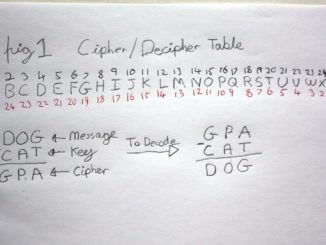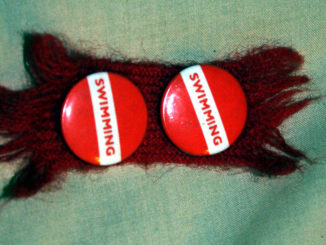
Sponsored Introduction – SPAD Report
Sir Montague Snoddgrass KC the special advisor to the Prime Minister’s Secretary’s budgie, Fred, has replaced his cleaner with a newer model. The old one, Elsie Dustall sucked-up one of his jigsaw pieces to Nymphs In The Nude and is now missing a tit in a bush. Elsie claims it was an accident as her old vacuum cleaner went berserk and was sucking up everything in sight.
“I took it to Doc Mike’s ‘We Fix Everything’ and he said it was a TIB problem and couldn’t do anything about it.”, she said.
Mrs Dustall will be replaced by Miss Titiana Handson.
“She gives everything a good stiff rubbing down ‘tll it comes up lovely. *grrrr*”, Sir Montague said.
End Of SPAD Report
More about vacuum cleaners and TIBs later. Meanwhile…
A Case Of Negative Influence
It was a late summer afternoon in the library of Peabody manor and the hot humid air was filled with an ominous feeling that something not too pleasant was about to break. A fact that was not helped by the verger who was attempting to ring a full peal on poor old St Catherine’s solitary bell and seemed to be signalling the end of the world.
The Admiral was down at the Pig’s Trotters Inn with Lord Wiggsby of Sty on the Wye. An interesting cove old Wiggers as his only language is Wigglish, which the Admiral speaks fluently. I know only two words of Wigglish: Yes (*oink oink*) and No (*oink, snort*). Some of you might know of Lord Wiggsby from the popular bi-monthly book review podcast ‘The Pencil Box’. No? Oh.
As I was saying, Thor was busy harvesting dark clouds while I sat pondering the meaning of it all with a half bottle of sherry wishing that I would have tagged along with Peabody to the Trotters Inn. Peabody, before he had buggered off to the pub, had been rummaging in the Manor’s potting shed and found an old kiddies’ snooker table. You know the sort of thing, twenty quid from Argos. The ‘bed’ is made from hardboard and usually warps, like this one had.
“Hey, fancy a game of Carambole?”, asked Peabody.
“No. In any case it’s a snooker not a billiard table.”, I replied.
“Here, stuff these in the pockets.”, he said as he taloned me three pairs of socks.
“I don’t think the Union Mondiale de Billard would approve. Anyway, you’ll be late for the pub.”, I said as he flew off chuntering something about escargot and pickles.
I took another sip of sherry and wandered over to the bookcase in search of something to stimulate and entertain the old grey stuff. Here are some of the goods on offer (actual books on the Doc’s bookshelf as I write this):-
Calculus, classic edition – not for a Sunday steaming hot afternoon thank you.
The Hound of the Baskervilles – excellent but I think I know who’s ‘done it’.
CMOS integrated circuit design – No.
Ancient Mysteries Of Britain – No, but interesting.
Physical Chemistry – My hydrogen atoms were spinning enough with the heat thank you.
Lasers And Infra-Red Fibre-Optic Systems – again, not now.
Counterpoint by Walter Piston – an excellent book but my temper was well cooked and my tenths and twelfths truly inverted as the storm gathered pace.
P.G.Wodehouse, P.G.Wodehouse, P.G.Wode… you get the idea.
How To Read The Tarot – as there was a rumble of thunder I certainly could divine what the weather was going to do.
The End Of Borley Rectory by Harry Price – you know, ‘the most haunted house in Britain’. A load of interesting nonsense and Harry certainly made his money from it. Good on him say I. I suppose that a lot of the ‘ghost hunting’ TV shows sprang up from him. Here’s one of the many photos inside:

This photo was taken in 1944, five years after the place ‘mysteriously’ burned ‘to the ground’ – well not quite as you can see. To paraphrase Douglas Adams’ Hitchhikers Guide: ‘The brick hung in the air the same way that bricks don’t’. Not that they would play around with double exposure in 1944 – just not cricket old chap. Anyway back to the bookcase…
Moving Things For Lively Youngsters – Ah, yes. Just about my intellectual level. A little science book that was first published in 1936 and was gifted to me by a teacher when I was still experiencing the delight of single figures of age, sadly long gone – both the teacher and my youth.
I turned to the chapter entitled ‘Electricity – The modern errand boy’. Don’t you just love the wording in old books!
Now, there are several ways of making electricity. The most common is by electromagnetic induction using a rotating magnetic field inside a coil of wire. The chances are it’s the electric you’re using right now. The second most common way is of course electro-chemically in the form of a battery and then there’s photo-electrically whereby photons make electrons move in a semiconducting material and by just having two substances at a different temperature – thermo-electrically, oh and piezo-electrically – crushing things. There is one other way: tribo-electrically. Basically rubbing things together to make static electricity.
I’ve spent many an hour in a darkened bathroom playing with myself…I mean a comb, to make tiny sparks on my finger tip. No wonder I’ve now got no hair! Here’s the image from the book that inspired me:
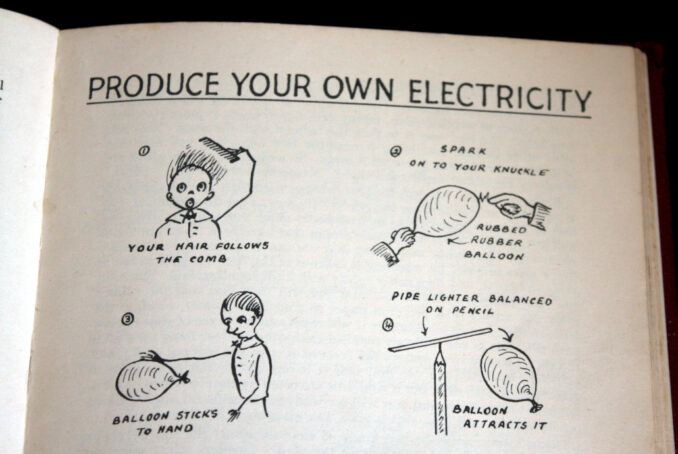
The question, that rolled around in my little mind, was how do I build a machine to make these tiny sparks happen continuously?
And that (hopefully) is what this article answers – “good grief Doc, talk about going the long way around to get to the point!”, I hear you cry. I know, but I had a jolly whizz of a time writing it. But before that let’s deal with the little matter of what electricity actually is and why the stuff costs us money.
What’s This Electric Bill About, Our Bill?
Good question, Mavis. For that answer we need to ask what is electricity? And the answer to that is simple: You, me and a coconut tree. In essence everything in the Universe is made of it. It is, of course, the true God particle (in my opinion): the electron.
Okay, Doc, if electrons are everything and electricity is electrons why don’t I get an electric shock when I touch stuff? Well, actually you do but it’s usually a very tiny amount. You see, electrons are lazy but they also like to move about. Above I mentioned different ways of making electricity but they all have one thing in common: WORK. That horrid four letter word. We have to put energy in to make electrons move and it’s that movement of electrons we call electricity and it’s that that costs us money.
It’s Not Net Zero, Ed. You F…ing Idiot
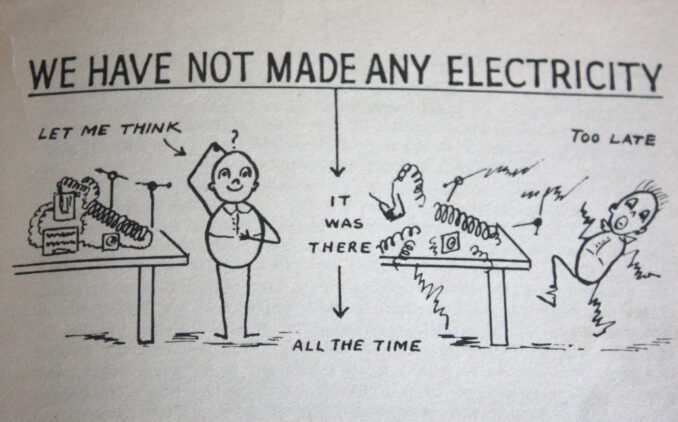
So electricity is simply the movement of electrons but we need to look a little deeper to understand how and why the sparks fly. I think that we all know that there are two types of electrical charge: positive (+) and negative (-), and that like charges repel and dislike attract – exactly the same as the north and south poles of a magnet. In fact, as we will see, the subjects of electrostatics and magnetism are two branches of the same tree.
You might recall from school science lessons that an atom is composed of three types of particle: electrons(-), protons(+), and neutrons(0). Electrons can move about, both inside their atom and outside to go to other atoms. Protons, the opposite charge of electrons, like to stay at home with their feet up drinking something nice no doubt – just like the Doc. Now, atoms usually have equal numbers of electrons and protons, we can ignore neutrons except for the fact that they make the steam for our turbines and can eliminate all life as we know it with big red buttons, but I digress. Therefore atoms at rest have a net-zero charge, Ed – you know? No electricity, zilch, nada, nowt Ed, you backwards git.
Electrons are randy little buggers always searching for their opposite sex – protons. Only the electrons can move to the protons and they like to stay close to each other but, as I’ve explained, they can be forced apart by magnetism, chemicals or just a good ‘ole rub down like in this simple experiment:

In the above photo I’ve hung a small aluminium foil ball (kitchen foil) from a gallows (two pencils glued together) dangling in front of an acrylic (Perspex) disc. Onto the disc is ‘stuck’ a piece of kitchen foil (if you hang around the Doc’s lab long enough you’ll realise that kitchen foil is one of the key ingredients for my silly experiments!). It’s ‘stuck’ or more likely trapped by the static electric charge that I created when I rubbed it against the plastic disc. This has made some of the electrons in the foil make a bee line for the surface of the disc leaving the poor old protons in the foil clinging on for dear life! What I’ve actually done is the first part in making some useful static electricity and this process is called charge separation.
Now, this is important: The protons can’t move to the separated electrons but the electrons found it fairly easy to move from the aluminium (a good electrical conductor) to the acrylic disc (a poor electrical conductor) and this makes it a one way street for them as they find it very difficult to hop back from the insulating disc. Hence the protons in the foil hold on to try and keep a net-zero charge. Note that the foil ball on the left of the image agrees to this state of affairs by just hanging vertically.
We don’t want net-zero, Ed you daft as a brick pin head, and I’m going to see to that by playing God, as the image on the right shows, by snatching the foil quickly away from the disc. Don’t worry, I’m a benevolent God and give the poor protons some of my electrons – I’m well fed and used to Thor zapping my atoms now and again.
I’ve left behind lots of extra electrons on the disc’s surface looking for a partner and the little foil ball’s protons say, ‘eye-eye, I think we’ll nip over there lads for a bit of crumpet!’ as can be seen in the right of the image – I’ve also drawn in what the charges might look like. Of course the protons can’t move but the attraction is strong enough to move the ball. A bit like a certain prophet and a mountain.
This net-negative charge between the disc and the ball is called the potential difference and is measured in volts – the amount of potential work the electrons can do. Now all we need is to find a way of storing them ready to do some useful work and that’s where experiment number two comes in:
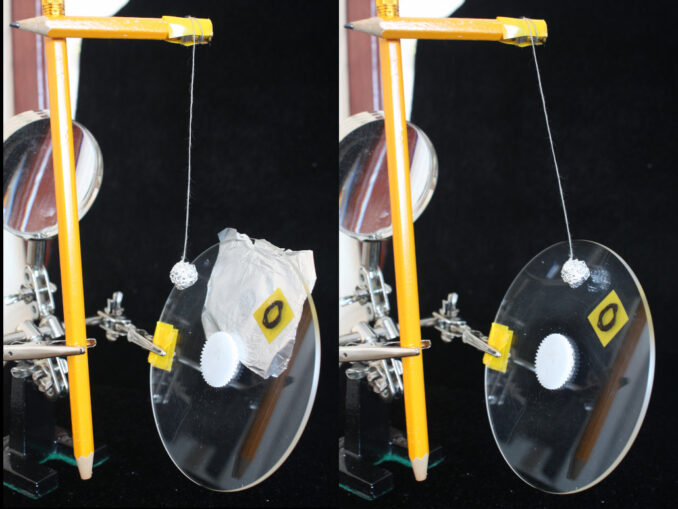
In the image above you’ll note the yellow sticker with a ‘0’ written on it. This is on the side of the disc facing the foil ball and that is the side I charged in the first experiment. You can see that the foil covers the sticker in the first image.
On the left I’ve charged the disc on the side facing away from the ball – you can still see the sticker to prove it. Now when I snatch the foil away I once again leave behind lots of surplus electrons but what happens to the ball? The plastic disc is an insulator so all that extra negative charge should not be able to get through to the other side but somehow it does as the little ball sticks to the disc!
What magic is this, Doc? This is a really important process and is why we all enjoy (or not) the wonders of modern electronics: electric permittivity. The magnetic equivalent is permeability. If you ‘stick’ a magnet on one end of a demagnetised nail (say) the other end of the nail will be able to pick up a paper-clip. The reason is that you have to imagine that the inside of the nail is composed of tiny magnets called dipoles. In a demagnetised state the magnetic-dipoles’ north and south poles are pointing in a random direction. When you apply a magnetic field they all point in the same direction magnetising the nail. N to S and S to N.
The same process happens with the plastic disc except it’s not magnetism that orients the dipoles it’s the electric field that I applied by leaving behind all those electrons. So all the positives point toward the negatively charged side leaving the negative side of the electric-dipoles pointing toward the little foil ball thereby attracting the attention of the protons. Simple.
It’s the reason the humble ‘capacitor’ works which is one of the key passive components used in all electronic circuits. Your TV and computer, amongst other goodies, would not work without the effect of permittivity. I make use of this process in my little electrostatic machine as we’ll see.
Well I’m sure you’ve had enough of me rambling on so until the next part I’ll leave you with this thought: The term ‘electrical circuit’ comes from the French ‘Le circuit électrique de la Formule Un’…now then, you learn something new everyday. 😉
© text & images Doc Mike Finnley 2024

